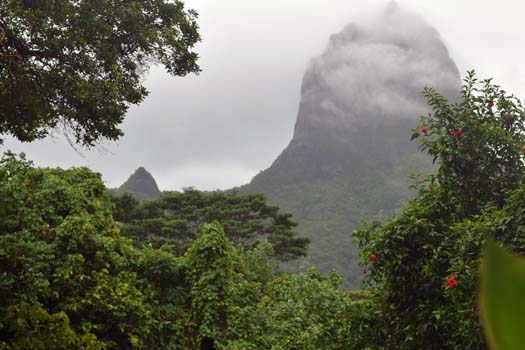
Editor’s Note: This is the 28th in a series of stories researched during Don and Nancy Harrison’s 50th Wedding Anniversary cruise from Sydney, Australia, to San Diego. Previous installments of the series, which runs every Thursday, may be found by tapping the number of the installment: 1, 2, 3, 4, 5, 6, 7, 8, 9, 10, 11, 12, 13, 14, 15, 16, 17, 18, 19, 20, 21, 22, 23, 24, 25, 26, 27
By Donald H. Harrison
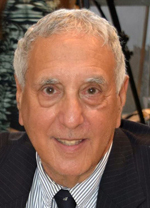
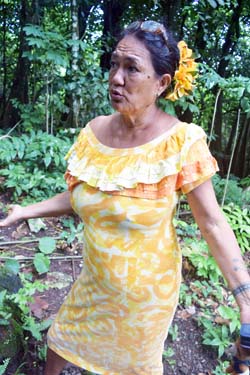
MOOREA, French Polynesia – Hinano Teavai-Murphy leads us to a corner of a ceremonial outdoor gathering place known as a marae and points out that one of its corners lines up exactly with the peak of Rotui, a sacred mountain for the Polynesian people. Rotui looks strikingly similar to the landform depicted in the animated Disney feature, Moana, on which Teavai-Murphy was credited as a cultural consultant. In November of every year, she explained to my wife Nancy and me, the constellation Pleaides, also known as the Seven Sisters, rises directly above that peak. When it does, the people of Moorea traditionally celebrated a New Year.
Because of their tenacity and long lives, sea turtles occupy a special place in traditional Polynesian New Year’s celebrations, Teavai-Murphy instructed us. Today, there is a ban on eating turtles, but in the past “when they killed a turtle, there was a ritual. You’d get together, share together, and on this tiny island, where everyone knows what you are doing, and people sometimes fight about land or resources, capturing a turtle was a time to forgive, and to share.” Today, she commented, Polynesians are unsure how to replace that ritual. “We eat fish every day,” she said. “How can we solve the problem? How can we replace this practice?”
This is just one example of the interrelationship between the physical environment and human culture. Today, at the University of California at Berkeley-administered Richard B. Gump South Pacific Research Station, where Teavai-Murphy serves as the associate director for administration and outreach, an ambitious project is underway to understand the 51-square-mile island of Moorea, with its population of 17,000 people and a variety of ecological zones, as a single system. Neil Davies, the British born-and-educated director of the Gump Station, explains: “If you think of Moorea as a fruit fly, or as a human, it is the same question as we ask in medicine: How to you respond to being exposed to different kinds of environmental stimuli? … If I live this type of life style with this much sun, exposed to these kinds of chemicals, or eat this sort of diet, what is the prognosis for my health?”
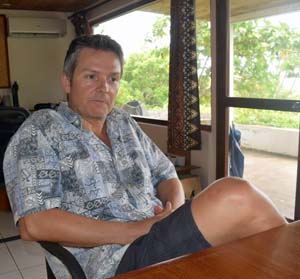
“We have the same thing with ecosystems,” Davies continued. “Moorea may be exposed to higher temperatures. When the temperature goes up a degree, how will Moorea respond? Will its reefs bleach and die? Will they be taken over by algae? Will we have an algal reef instead of a coral reef? Will that affect the economy of the island? It may not be good for tourism. It may not supply as much food for the locals. We try to make those kind of predictions. … We are pretty sure that the ocean will become more acidic and that temperatures will go up and, frankly, the people of Moorea can’t change that. It is irreversible at this stage. So, what are the consequences of that? What are the things that we can do? What kind of things should we build? The fishery management policies that we have, will they change?”
Davies pointed out that decisions responding to the environment and affecting its future growth are “up to the people and the political system to decide.” Moorea, which is approximately the same geographic size as San Francisco, has a local government on the island, and a regional government in Papeete, which, located on the nearby island of Tahiti, is the capital city of French Polynesia. Beyond that, there is the government of France which reserves to itself the functions of defense, security, justice, and university education. More remote in the decision-making chain are the European Union and the United Nations.
 The Gump Station was donated in 1981 for research to the University of California system by Richard B. Gump of the Jewish family that operated Gump’s, which is self-described as “the legendary San Francisco destination for luxury gifts, jewelry, artful objects and home decor.” Davies has served in Moorea as director of the Gump Station since the Year 2000, with one of his major accomplishments being the leadership of a four-year Biocode project to identify and genetically sequence every macroscopic species of animal and plant on the island of Moorea. Currently, between 7,000 and 8,000 species have been identified. “The goal,” he said, “is to get specimens – one or two for each species. Once they are deposited in a museum and we have photos of each of them, we sequence their genes. We tag every species, so that we have these markers and they are in the system, and you can find it again.”
The Gump Station was donated in 1981 for research to the University of California system by Richard B. Gump of the Jewish family that operated Gump’s, which is self-described as “the legendary San Francisco destination for luxury gifts, jewelry, artful objects and home decor.” Davies has served in Moorea as director of the Gump Station since the Year 2000, with one of his major accomplishments being the leadership of a four-year Biocode project to identify and genetically sequence every macroscopic species of animal and plant on the island of Moorea. Currently, between 7,000 and 8,000 species have been identified. “The goal,” he said, “is to get specimens – one or two for each species. Once they are deposited in a museum and we have photos of each of them, we sequence their genes. We tag every species, so that we have these markers and they are in the system, and you can find it again.”
As lead investigator for the project, Davies coordinated the work of “teams from all over the world who came to Moorea and it was kind of like a big scavenger hunt – specialists in each taxonomic group—and they were challenged to find all the species in their group, wherever it was that they thought they might find them.” The samples were sent to several museums around the world, “depending on who led the taxonomic group,” Davies said. “For example, the French team led the fish study, so they have one of each specimen in Paris, another at the Smithsonian in Washington, D.C. All the specimens in these international museums are databased and accessible to scholars around the world as part of this global network.”
Today, the Gump Station also is base camp for student projects, both at the graduate and undergraduate level, from such University of California campuses as Berkeley, Los Angeles, Santa Barbara, and San Diego.
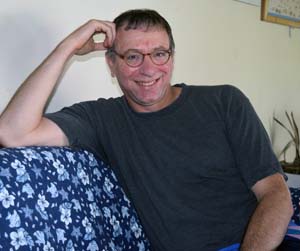
On the day in February 2018 that we visited, undergraduates from UCLA, working in groups of three, were completing month-long projects under the tutelage of Profs. Peggy Fong and Dan Blumstein, the latter a member of the Jewish community. “Peggy’s course broadly is marine biology, mine is animal behavior,” Blumstein told us. Fifteen UCLA undergraduates take the course, spending 2-3 weeks in California defining their projects before traveling as a group to Moorea to do between three and four weeks of field work. “We’re analyzing data, getting things written up, and for three more weeks students will be giving public talks on their projects and writing papers,” Blumstein said. “A lot of them will be published.”
A type of lizard known as a skink dwells on the island of Moorea, and two questions under investigation by students were how adaptable are the skinks to human proximity, and how do they respond to the sounds made by predators. In the latter study, said Blumstein, “We broadcast to them certain sounds. We see them increasing the rate of looking, and then running.” On the other hand, some sounds do not seem to affect the skinks at all, even though they are novel to them.
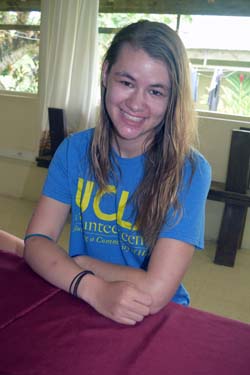
Maddy Krohn, a UCLA junior, described the skinks as being “tiny little lizards, about 12 centimeters long, with bright blue tails, pretty distinctive. What we’re doing is that we are seeing how close we can get to them before they run off, and we are doing this multiple times to see if they will habituate to having us around. What we did is that we went out in the wilds of Moorea, where there are lots of lizards, and we had stick markers. We would mark our starting position and the we would see a lizard and walk toward it. As soon as it ran off, we dropped another marker for the Flight Initiation Distance (FID), to determine how close you can get to them. We were trying to determine if there was a difference in FIDs between those who live in human-heavy environments and those that live in more wild places.” Their research premise was that skinks living close to humans would be less scared of humans than those living in the wild places, but in fact there seemed to be no statistical difference.
Another student project involved giant clams. “When clams get scared, they close down,” the professor said. “What scares clams? Shadows passing over them, and things touching them. If you look very carefully at the clams—if you take pictures of their mantle – you can see that they have lots of scars where fish have come and wounded them, and they heal. Clams are interesting because they photosynthesize. They need to stay open to the sun, so there is a whole literature on optimal escape behavior. When a clam is not doing something that gets it energy, resources, or mates, because it is hiding, or running away, it is costly. We find that clams are behaving not only in ways that show costs and benefits of hiding, but that they also have individual propensities in their responses, personalities so to speak. … They don’t have eyes, they have photosensors, so they can detect different type shadows and they classify these things differently. They detect and discriminate between someone tapping on their shell and someone trying to touch their mantle. You don’t think of clams as cognitively complex, yet they have the ability to assess threats in a graded way, which is pretty slick.”
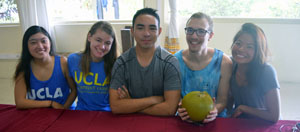
My Nguyen, a UCLA student hailing from Santee, California, described the clams as “quite beautiful – their average size is 10 centimeters upwards, and they come in all sorts of colors—purples, blues, and greens. We wanted to look at their cognition. They respond to shading and to touch by closing their shell. We wanted to see if they would respond differently to different types of threats, so we determined a set of five different stimuli and we ranked them in order of danger. So we have a mantle touch, shell tap, and large, medium, and small shade. We repeated a certain stimulus four times at a certain interval to see if their response decreases, so that they habituate to them … We found out that they do habituate to all stimuli, even the most adverse one which is the mantle touch, and that they do recover to all of them, meaning that these clams can actually categorize different threats, which is pretty cool.”
The papers written by Kohn, Nguyen and the other students who traveled to Moorea count not only for grades, but in some instances will be published in academic journals –a real bonus for the students as they apply to graduate school or medical schools.
Before our arrival in Moorea, I had the opportunity to interview by phone another member of the Jewish community, Prof. Jonathon Stillman of UC Berkeley, who told me that the property at the Gump Station has been improved thanks to a grant from the Gordon and Betty Moore Foundation, Gordon having been the head of Intel. Stillman said that “The Gump Station is the home of our nation’s only long-term ecological coral research,” a project funded by the National Science Foundation and directed by scientists from UC Santa Barbara and California State University at Northridge.
In the 13-unit class that he teaches for UC Berkeley students, “we have about two weeks of classroom work on campus, and then we fly down to French Polynesia, where the class continues for nine weeks,” Stillman related. “The first week or so we give the students an intensive tour of the island. We show them all the different types of habitats. We talk about the interesting observations that we can make, and we do some practical exercises like field sampling, and then the students are given some time to think about projects they would like to do. Students have to do projects that are novel, that have never been done before. They have to be feasible within a six-week period of time … The students work in the field, work in the lab, work in the forest, work on the reef – it depends what the nature of their project is. I think the really interesting thing for us as instructors is that we never know what we have to be able to teach. I need to learn what they need to learn. It is really empowering for the students, because they get to be the scientists. They get to figure out what they are going to do, and then actually do it, and the product of the class is a professional paper that they give at a symposium.”
Stillman recalled one student project which was about “the effect of ocean acidification on embryonic sea urchins. They are little spiky animals; they are grazers. Their populations go up and down over time and lot of it depends on the success of their embryos. So, when they reproduce the sea urchins put sperm and egg into the water, and they combine in the water to produce the embryos that then develop in the water. If the temperature of the water changes, or the pH of the water changes, it can affect their development. So. one student, Brent, took all the possible species of sea urchins and he induced them to release their sperm and egg, and then he crossed the sperm and the egg of different parents together, and raised them under different conditions. His study showed that urchins are extremely sensitive to even slight reductions in pH levels. That was a really nice project. No one had ever done that before with tropical urchins, although we do have data for urchins in temperate zones like the ones who live along the California coast.”
Another project involved the partula snail, which is native to French Polynesia. French colonizers had introduced another snail to Polynesia – one favored for eating by those who love escargot. When escargot snails escaped their controlled environment and were loose in the forests of Moorea, they became real pests, “eating all the vegetables and a lot of the forest,” Stillman related. So, the authorities introduced a carnivorous snail which could eat the escargot snail. “But it liked to eat partula snails, which were mostly wiped out. We thought they had gone completely extinct in Moorea until they recently were discovered by the UC Berkeley class a number of years ago.” As one student learned through her project, it turned out that the partula snail had thrived in a clear-cut area.
Another UC Berkeley project involved releasing partula snails that had been raised in captivity in England back into the fields of Moorea. “One of our students was able to monitor those re-released snails and to figure how well they survived after being re-released and how far they moved after being re-released,” Stillman said.
Stillman said that sea urchins and partula snails are both important contributors to Moorea’s environment.
“In healthy systems, the urchins will reduce the amount of algae, which tends to compete with coral. So, on a healthy coral reef there is an abundance of grazers, with the urchins grazing down the algae,” Stillman said. “Partula snails in their system graze the leaves and help the plants grow better, because when leaves are covered with epiphytes, it can reduce the photosynthetic performance of the plants.”
*
Harrison is editor of San Diego Jewish World. He may be contacted via donald.harrison@sdjewishworld.com
Pingback: Guide shares the Happe- ness of travel | San Diego Jewish World
Pingback: Cruise ship fun at the Equator | San Diego Jewish World